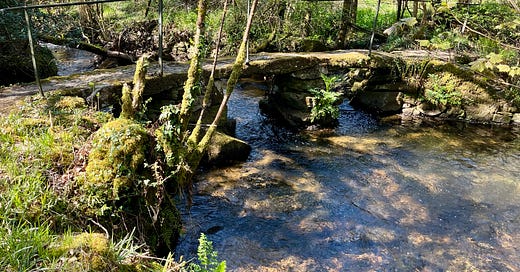A trio of lads; 15-year-old Henry Hooper, a Miller, with his Loader helpers 10-year-olds Jonathan Harris and James Hambly make up the first of just seven households which constitute the hamlet of Trevague on the 1841 Census.
My map (Ordnance Survey Cornwall XXII.1 Surveyed: 1882, Published: 1884 – for those who care about the important things in life) shows the Corn Mill to the southeast of downtown Trevague, the sandwiched between the River Lynher and a mill leat.
I saw no mill as I ambled north, down the contours, from Newton towards Trevague on a sunny April afternoon, but some dilapidated stone walls, long since surrendered to moss and ivy, caught my eye a few yards after crossing a simple stone footbridge, which had saved my socks at the ford across the Lynher. Maybe that was the spot?

On first reading it seemed rather alarming that the mill was operated by a teenager with a pair of ten-year-old sidekicks. I remind myself how novel the luxury of constancy we enjoy in our names and dates is, and recall that for those aged 15 and over, ages were rounded down to the nearest half-decade on the 1841 census, such were the vagaries of birth details.
Cross checking with other records tells me that Henry was in fact the grand age of 19 by census night in April 1841, so whilst the mill team might seem young to our 21st century sensibilities, it’s not implausibly so.
Skip down two households on the census and we find my 3xgreat grandparents, tin streamer William Harper with wife Mary Ann, son James (aged 2), baby Thomas and servant girl Elizabeth Lander.
Two entries further on again, the final household in Trevague, and here are my 4xgreat grandparents, James and Mary Hambly with Mary Ann’s 18-year-old sister Emlyn still living at home (Emmeline on other records – try out both spellings with a Cornish accent and you’ll find they are closer on the tongue than they are to the eye).
Seven households, three of which I already know my ancestors called home. The Venn diagram of community and family runs tight here.
It seems reasonable to conclude that mill loader James Hambly is Mary Ann’s youngest brother James, baptised at St Nonna’s Altarnun in the summer of 1826, and my 3xgreat granduncle. Maybe the enumerator for Altarnun was overzealous in his application of the age-rounding instructions when recording James’ age as 10 (… no, it might not have been her … sadly no one wanted women to be tiring their dainty little lady fingers on man-tasks like enumerating the census until 1891).
If I’ve got my James Hamblys straight, this one will become a copper miner, moving westwards from Trevague, via Tregenna to Trenilk on the census returns that chart his life. The same hamlets that had marked out the route of my walk from the Rising Sun, via St Nonna that afternoon. His life lived in homes less than a mile apart.
The miller, Henry Hooper, marries my 3xgreat grandaunt Emmeline in 1844 after what I’m sure was a long and discerning search for a spouse on the parts of the only two single young adults in the village. Their lives concluded 11,000 miles away, settlers, or squatters, on the land of the Dja Dja Wurrung and Taungurung People.






There's something oddly appealing about living your life in homes a mile apart